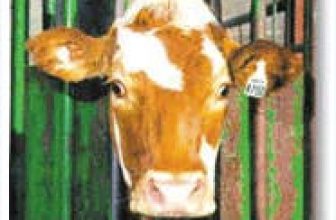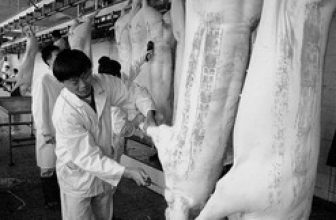
Guangdong Province RFID Animal Traceability Management System
[ad_1]
“RFID animal traceability management system” mainly realizes the various aspects of breeding enterprises in the breeding production process (entry, daily feeding, epidemic prevention, disease, feeding, growth cycle reminder, exit, milking, etc.), employee management, financial accounting, etc. Informatization management improves the level of enterprise informatization. The system uses RFID technology together with database technology, network technology, distributed computing and other technologies to establish an automated cattle breeding system to realize information integration, query and monitoring. The system should provide complete management functions and automatically form various reports for the health of cattle Early warning mechanism for growth realization.

1. Use value
1. Establish identity management and establish identity marks for grazing cattle and its products
The system has an electronic identification for each cow, and the identification has 16 significant digits, which can be obtained one by one for the condition of each cow without confusion, duplication, or change, ensuring that all items of the managed object The data and indicators are absolutely accurate and reliable.
2. Establish controllable management
Standardize the production process of enterprise aquaculture, reduce the incidence of evasable problems such as errors, errors, and omissions caused by pure manual records;
3. Realize the tracking and tracing of the whole process information of cattle breeding and immunization
After adopting this system, since the diet, exercise, and health status of each cow in each unit can be automatically controlled 24 hours a day, and health warnings are set in the computer, any epidemic and ordinary epidemics can be automatically recognized, and It can be confirmed and processed in time, and its controllability is extremely high. It is easy to use the computer to obtain the macro or individual status of inventory, listing, epidemic situation, etc., and make accurate choices about it. Once a problem occurs, it can be traced back to each specific cow, so that timely measures can be taken.
4. Establish information management
The growth cycle value of each stage is set in advance, and the system automatically reminds when it expires, which plays a role in supervising and assisting employees in the continuous and time-effective work process.
2. Solve the problem
1. Cost-saving: The application of the system reduces human participation while rationally planning various positions in the enterprise, reducing errors, errors, and leakage, reducing losses, and saving costs;
2. Clarify employee responsibilities: The system saves complete historical data for the company. If there is a problem in the link, the responsibility can be assigned to the person as soon as possible;
3. Quality management: standardize the system process, automatically collect key node data, which can be viewed in the forward direction and traceable in the reverse direction, ensuring high-quality, safe and reliable products;
4. Improve efficiency: With the help of information management system, standardize the production process, replace labor in some links with equipment to ensure continuous data connection, true and effective, reduce labor costs, post responsibility system, clarify the division of responsibilities, and reduce the incidence of accidents, which is greatly overall Improve production efficiency and management efficiency.
3. System business process
(1) Information about farms and cattle houses
Register the information of the breeding farms and cattle houses of the company or related cooperative units in detail, and the specific information can be recorded in the information, such as: the scale, location, ownership list, age, person in charge, slaughter volume, environment and other parameters of the farm.
(2) Variety information
Register all live cattle or other carcass information of all the company’s breeding farms, including carcass breeds, codes, growth conditions, disease records, immunization records, and estimated time for slaughter.
(3) Production material management
Material (mainly for raw materials) information is registered in the system, and the operator enters the material name, material composition, purchase time, purchase manufacturer and other information into the breeding management system through the software. Establish material source data for the entire management system.
(4) Epidemic prevention and immunization information
Registering the epidemic prevention and immunization standards of different breeds or categories of live cattle will facilitate the system to automatically raise early warnings in the future. For example, cattle A43 needs routine epidemic prevention this week, which can greatly reduce work stress and improve work efficiency for farm staff.
(5) Information on diseases and abnormal symptoms
Register frequently-occurring diseases and abnormal symptoms, which can specifically include the type of disease, the course of damage, and the response method.
(6) Health information of raw cattle
Automatically compare the susceptible and less ill cows, do a sorted display, and record the cause of the cow, the disease treatment personnel, the time, the recovery status, the number of the sick cows, the weight, the breed, the medicine used, the degree of recovery after the treatment, etc.
(7) Live cattle entry information
Record farm number, house number, column number, ear tag ID number, file number, date of birth, species, mother species and number, father species and number, entry time, purpose, weight, etc.
(8) Live cattle slaughter information
The system can automatically remind relevant personnel of the code, weight and date of cattle to be slaughtered in the near future based on the previous feeding and other data.
(9) Cow milk production information
The system can automatically prompt relevant personnel to collect milk, weight, and date in the near future based on the cow’s fertility, lactation period and other data. One-to-one statistics on monthly, quarterly and annual milk production;
(10) Veterinary drug information
Register all veterinary drugs used, including manufacturers, distributors, types of veterinary drugs, response symptoms, expiry date, etc.
(11) Disinfection management
Perform disinfection operations on farms and cattle houses according to regulations, and register the consumption results such as disinfection time, disinfection personnel, disinfection cycle, disinfection drugs, and disinfection cattle house numbers in the system.
(12) Temperature information management:
Temperature is the most important factor affecting the growth of raw cattle, and it is particularly important to ensure the normal body temperature of raw cattle.
(13) Live cattle sales management
Real-time registration and real-time query of the sales of live cattle.
(14) Live cattle slaughter rate information
This system can generate a graph of the number of cattle slaughtered in the past 2 years, the slaughter rate of the cattle barn is arranged in order, and record the high and low cattle breeds of the slaughter rate. And it can automatically analyze the reasons for the imbalance in the slaughter rate from different perspectives such as live cattle breeds, feed ratios, body temperature detection, and disease immunity, and display them in the form of reports.
(15) Enterprise information management
Data upload: The data collected during the breeding process is stored in the handheld, and the handheld and the farm management system complete the data transmission through wireless means. The business data generated by the breeding management system is automatically uploaded to the management center via the Internet.
Financial management: carry out financial data statistics, form various statements, and implement and grasp the income situation;
Personnel management: standardized management of breeding personnel inspection, attendance, etc.;
Optional function:
Automatic temperature and humidity control: through the monitoring of environmental temperature and humidity, automatic control of related temperature and humidity adjustment equipment.
Ultrasonic automatic disinfection channel: The system is equipped with an ultrasonic automatic disinfection channel for thorough disinfection and no dead ends.
Electronic monitoring system: monitor whether the operation of the breeder is standard, observe the condition of the cattle, and allow outside visitors and purchasers to watch the video images of the cattle farm.
[ad_2]





